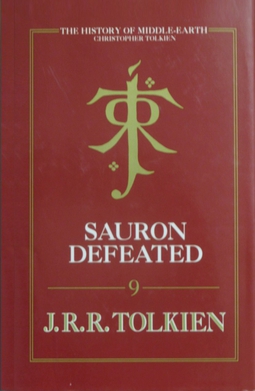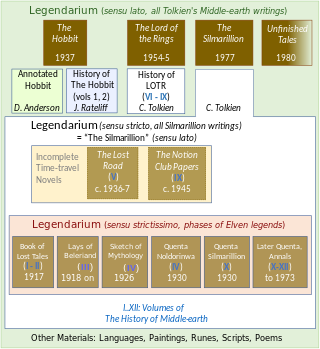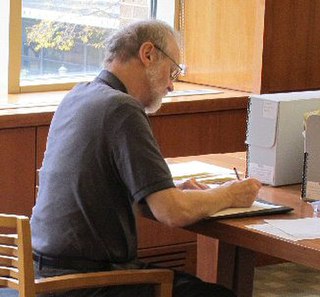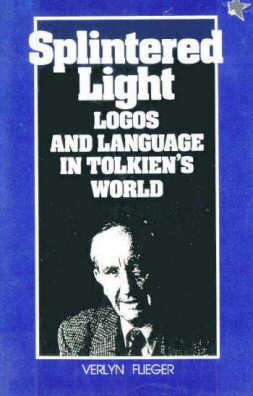
The History of Middle-earth is a 12-volume series of books published between 1983 and 1996 by George Allen & Unwin in the UK and by Houghton Mifflin in the US. They collect and analyse much of J. R. R. Tolkien's legendarium, compiled and edited by his son Christopher Tolkien. The series shows the development over time of Tolkien's conception of Middle-earth as a fictional place with its own peoples, languages, and history, from his earliest notions of "a mythology for England" through to the development of the stories that make up The Silmarillion and The Lord of the Rings. It is not a "history of Middle-earth" in the sense of being a chronicle of events in Middle-earth written from an in-universe perspective; it is instead an out-of-universe history of Tolkien's creative process. In 2000, the twelve volumes were republished in three limited edition omnibus volumes.

Thomas Alan Shippey is a British medievalist, a retired scholar of Middle and Old English literature as well as of modern fantasy and science fiction. He is considered one of the world's leading academic experts on the works of J. R. R. Tolkien about whom he has written several books and many scholarly papers. His book The Road to Middle-Earth has been called "the single best thing written on Tolkien".
Tolkien fandom is an international, informal community of fans of the works of J. R. R. Tolkien, especially of the Middle-earth legendarium which includes The Hobbit, The Lord of the Rings, and The Silmarillion. The concept of Tolkien fandom as a specific type of fan subculture sprang up in the United States in the 1960s, in the context of the hippie movement, to the dismay of the author, who talked of "my deplorable cultus".

The Mythopoeic Awards for literature and literary studies are given annually for outstanding works in the fields of myth, fantasy, and the scholarly study of these areas. Established by the Mythopoeic Society in 1971, the Mythopoeic Fantasy Award is given for "fiction in the spirit of the Inklings", and the Scholarship Award for non-fiction work. The award is a statuette of a seated lion, with a plaque on the base. It has drawn resemblance to, and is often called, the "Aslan".
The works of J. R. R. Tolkien have served as the inspiration to painters, musicians, film-makers and writers, to such an extent that he is sometimes seen as the "father" of the entire genre of high fantasy.
Do not laugh! But once upon a time I had a mind to make a body of more or less connected legend, ranging from the large and cosmogonic to the level of romantic fairy-story... The cycles should be linked to a majestic whole, and yet leave scope for other minds and hands, wielding paint and music and drama. Absurd.
The works of J. R. R. Tolkien have generated a body of research covering many aspects of his fantasy writings. These encompass The Lord of the Rings and The Silmarillion, along with his legendarium that remained unpublished until after his death, and his constructed languages, especially the Elvish languages Quenya and Sindarin. Scholars from different disciplines have examined the linguistic and literary origins of Middle-earth, and have explored many aspects of his writings from Christianity to feminism and race.

Tolkien's legendarium is the body of J. R. R. Tolkien's mythopoeic writing, unpublished in his lifetime, that forms the background to his The Lord of the Rings, and which his son Christopher summarized in his compilation of The Silmarillion and documented in his 12-volume series The History of Middle-earth. The legendarium's origins reach back to 1914, when Tolkien began writing poems and story sketches, drawing maps, and inventing languages and names as a private project to create a mythology for England. The earliest story, "The Voyage of Earendel, the Evening Star", is from 1914; he revised and rewrote the legendarium stories for most of his adult life.

Tolkien's Legendarium: Essays on The History of Middle-earth is a collection of scholarly essays edited by Verlyn Flieger and Carl F. Hostetter on the 12 volumes of The History of Middle-earth, relating to J. R. R. Tolkien's fiction and compiled and edited by his son, Christopher. It was published by Greenwood Press in 2000. That series comprises a substantial part of "Tolkien's legendarium", the body of Tolkien's mythopoeic writing that forms the background to his The Lord of the Rings and which Christopher Tolkien summarized in his construction of The Silmarillion.
Verlyn Flieger is an author, editor, and Professor Emerita in the Department of English at the University of Maryland at College Park, where she taught courses in comparative mythology, medieval literature, and the works of J. R. R. Tolkien. She is well known as a Tolkien scholar, especially for her books Splintered Light, A Question of Time, and Interrupted Music. She has won the Mythopoeic Scholarship Award four times for her work on Tolkien's Middle-earth writings.

The History of The Hobbit is a two-volume study of J. R. R. Tolkien's 1937 children's fantasy novel The Hobbit. It was first published by HarperCollins in 2007. It contains Tolkien's unpublished drafts of the novel, with commentary by John D. Rateliff. It details Tolkien's various revisions to The Hobbit, including abandoned revisions for the unpublished third edition of the work, intended for 1960, as well as previously unpublished original maps and illustrations drawn by Tolkien.
John D. Rateliff is an American independent scholar of fantasy literature and author of roleplaying games. He specializes in the study of the works of J. R. R. Tolkien, particularly his Middle-earth writings, and wrote and edited the 2007 book The History of the Hobbit.
Elizabeth Solopova is a Russian-British philologist and medievalist undertaking research at New College, Oxford. She is known outside academic circles for her work on J. R. R. Tolkien's Middle-earth writings.

A Companion to J. R. R. Tolkien is a 2014 book edited by Stuart D. Lee and published by Wiley-Blackwell. It is a part of the Blackwell Companions to Literature series, which have been described as prestigious reference works, and features authors well known in the field of Tolkien studies.
In J. R. R. Tolkien's epic fantasy The Lord of the Rings, an oliphaunt is a giant war elephant, used by the army of the Haradrim. Tolkien borrowed the word from Middle English to give a rustic feeling to Sam Gamgee's speech. The beasts are first mentioned by Sam as he explains to Gollum what an oliphaunt is; he hopes to see one. His wish is fulfilled as he witnesses Faramir's ambush of a contingent from Harad in Ithilien. Several mûmakil take part in the Battle of the Pelennor Fields.
John Garth is a British journalist and author, known especially for writings about J. R. R. Tolkien including his biography Tolkien and the Great War and a book on the places that inspired Middle-earth, The Worlds of J. R. R. Tolkien. He won a 2004 Mythopoeic Award for Scholarship for his work on Tolkien. The biography influenced much Tolkien scholarship in the subsequent decades.

Richard Carroll West was an American librarian and one of the first Tolkien scholars. He is best known for his 1975 essay on the interlace structure of The Lord of the Rings, for which he won the 1976 Mythopoeic Scholarship Award for Inkling Studies.
Stuart Dermot Lee is a British specialist in information technology at Oxford University Computing Services and a Reader in E-learning at Oxford University, but is best known for his scholarly books on J. R. R. Tolkien. He has written several plays, two of which won Oxford Playhouse new writing awards.
Gergely Nagy is a Hungarian medievalist and a well-known Tolkien scholar.

Splintered Light: Logos and Language in Tolkien's World is a 1983 book of literary criticism by the leading Tolkien scholar Verlyn Flieger, in which she argues that light is a central theme of Tolkien's Middle-earth mythology, in particular in The Silmarillion. It has been admired by other scholars to the extent that it has become a core element of Tolkien scholarship.

The fantasy writings of J. R. R. Tolkien have had a huge popular impact. His Middle-earth books have sold hundreds of millions of copies. The Lord of the Rings transformed the genre of fantasy writing. It and The Hobbit have spawned Peter Jackson's Middle-earth films, which have had billion-dollar takings at the box office. The books and films have stimulated enormous Tolkien fandom activity in meetings such as Tolkienmoot and on the Internet, with discussion groups, fan art, and many thousands of Tolkien fan fiction stories. The mythology's Orcs, Trolls, Dwarves, Elves, Wizards, and Halflings are firmly established in popular culture, such as in the tabletop role-playing game Dungeons & Dragons, and in Middle-earth video games. Individual characters like Gollum, too, have become familiar popular figures, for instance featuring in a song by Led Zeppelin.












